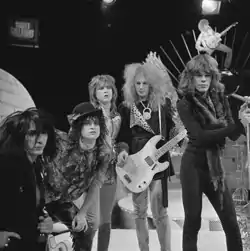Glam punk
Glam punk (sometimes called mock rock)[1] is a term used retrospectively to describe a short lived trend for bands which produced a form of proto-punk that incorporated elements of glam rock, initially in the early to mid-1970s. Acts included New York Dolls and Harlots of 42nd Street.[2]
| Glam punk | |
|---|---|
| Other names | Mock rock |
| Stylistic origins | |
| Cultural origins | Early 1970s, New York City |
| Derivative forms | |
| Other topics | |

History
Glam punk has been seen as a backlash to the hippie folk music sensibilities of the 1960s.[3] Lucy O'Brien defines the New York Dolls style as combining "Rolling Stones raunch with heavy borrowings from the girl group era".[4] The band was highly influential in New York City's club scene of the early 1970s, as well as later generations of musicians,[1] and their style was adopted by a number of New York bands, including Harlots of 42nd Street.[5] The Dolls broke up in 1976, by which time the trend had already metamorphosed into punk and begun to move on to new wave.[6]
Influence
The New York Dolls helped spark the beginning of punk rock, with Malcolm McLaren informally managing them in 1975, before returning to England,[7] where he and Vivienne Westwood used the New York Dolls, as well as other bands that they had seen while in New York, as inspiration for punk fashion and the creation of the Sex Pistols.[8] They also influenced the glam metal scene that emerged in the 1980s, through the adoption of glam aesthetics by bands including Hanoi Rocks,[9] Mötley Crüe[10] and Guns N' Roses.[11]
The term has been used to describe later bands who combined glam aesthetics with punk music, including The DTEASE and early Manic Street Preachers.[12] Glam punk was a major influence on bands of the New York post-punk revival that included D Generation, Toilet Böys and The Strokes.[13]
See also
Notes and references
- T. Givens, People of Paradox: a History of Mormon Culture (Oxford: Oxford University Press, 2007), ISBN 0-19-516711-2, p. 281.
- Stevie Chick (13 June 2011). "The New York Dolls play 'mock rock' on British TV". The Guardian.
- C. Havranek, ed., Women Icons of Popular Music: the Rebels, Rockers, and Renegades, vol. 1 (Westport, CT: Greenwood, 2009), ISBN 0-313-34084-6, p. 164.
- Lucy O'Brien, She Bop II: The Definitive History of Women in Rock, Pop and Soul (Continuum, 2002), ISBN 0-8264-7208-7, p. 258.
- M. H. Ditmore, Encyclopedia of Prostitution and Sex Work, vol. 2 (Westport, CT: Greenwood, 2006), ISBN 0-313-32970-2, p. 408.
- Brian McNair, Striptease Culture: Sex, Media and the Democratization of Desire (London: Routledge, 2002), ISBN 0-415-23734-3, p. 136.
- David Gross. "David Johansen". Perfect Sound Forever. Archived from the original on 29 December 2010. Retrieved 25 February 2012.
- R. Moore, Sells like Teen Spirit: Music, Youth Culture, and Social Crisis (New York: NY, NYU Press, 2009), ISBN 0-8147-5747-2, p. 47.
- D. Bukszpan, The Encyclopedia of Heavy Metal (New York City, NY: Barnes and Noble, 2003), ISBN 0-7607-4218-9, p. 85.
- N. Strauss, The Dirt: Confessions of the World's Most Notorious Rock Band
- S. Davis, Watch You Bleed: The Saga of Guns N' Roses (New York, NY: Gotham Books, 2008), ISBN 978-1-59240-377-6, p. 30.
- R. Jovanovic, A Version of Reason: The Search for Richey Edwards (London: Hachette UK, 2010), ISBN 1-4091-1129-6.
- J. S. Harrington, Sonic Cool: the Life and Death of Rock 'n' Roll (Milwaukee, WI: Hal Leonard Corporation, 2003), ISBN 0-634-02861-8, p. 538.
